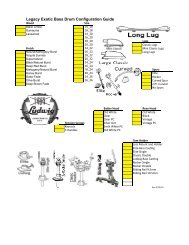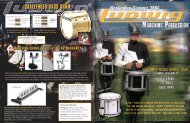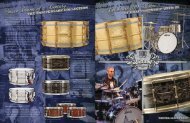INSIDE - Ludwig
INSIDE - Ludwig
INSIDE - Ludwig
Create successful ePaper yourself
Turn your PDF publications into a flip-book with our unique Google optimized e-Paper software.
<strong>INSIDE</strong><br />
Centennial<br />
LUDWIG<br />
DRUMS<br />
The venerable drum maker, still a serious player on<br />
the world stage, celebrates its centennial this year.<br />
Surviving the Depression, the potentially overwhelming<br />
demands of Beatlemania, and the ire of Buddy Rich.<br />
The year was 1909. William<br />
Howard Taft was president of<br />
the United States. The Model T<br />
automobile was on the road. Broadcast<br />
radio was just three years old and was<br />
still in limited use. It was the dawn of<br />
the recording business, with many<br />
people still listening to wax cylinders.<br />
And it was when <strong>Ludwig</strong> & <strong>Ludwig</strong><br />
was founded.<br />
The year is 2009. Barack Obama is the<br />
first African-American U.S. president. An<br />
airplane can fly from the East Coast to<br />
the West in under six hours. Portable<br />
entertainment devices like iPods bring<br />
music and video to listeners wherever<br />
they may be. And the <strong>Ludwig</strong> Drum<br />
Company celebrates its centennial—<br />
by Lauren Vogel Weiss<br />
something extraordinary for any business,<br />
especially in the music industry.<br />
“The <strong>Ludwig</strong> brand never went<br />
away,” explains Jim Catalano, director<br />
of sales and marketing for <strong>Ludwig</strong>/<br />
Musser School And Concert Percussion<br />
and a member of the <strong>Ludwig</strong> “family”<br />
for twenty-six years. “There were times<br />
that were up…and down…but we persevered<br />
while many others did not.”<br />
Faced with having to play fast ragtime<br />
rhythms on a bass drum, William F.<br />
<strong>Ludwig</strong> Sr. invented a pedal with a<br />
short beater rod connected close to the<br />
playing spot. He used it during performances<br />
of the Ziegfeld Follies of 1909,<br />
and soon other drummers wanted one<br />
too. Bill and his brother Theobald<br />
opened a small drum shop called<br />
<strong>Ludwig</strong> & <strong>Ludwig</strong>, and they patented<br />
this revolutionary idea and made pedals<br />
Legacy Classic<br />
MODERN DRUMMER • NOVEMBER 2009<br />
Reprinted by permission of Modern Drummer Publications, Inc. © 2009
THE CLASSICS NEVER GO OUT OF STYLE<br />
<strong>Ludwig</strong> looks to its rich history—and to the future—with its latest models.<br />
<strong>Ludwig</strong> is celebrating its centennial with<br />
a splash, introducing many new (and<br />
“old”) products. The “Snare Drums Of A<br />
Century” Anniversary Collection includes a<br />
replica of the 1928 Gold Triumphal snare<br />
drum. “We’re making only one hundred of<br />
them,” Jim Catalano, director of sales and<br />
marketing for <strong>Ludwig</strong>/Musser School And<br />
Concert Percussion, says of the $10,900<br />
snares. “Each drum is serialized by a date<br />
in <strong>Ludwig</strong>’s history.” <strong>Ludwig</strong> has also<br />
introduced special 100th Anniversary<br />
Black Beauty snares as well as “The<br />
Replica 1928 Gold Triumphal snare<br />
Chief” Supra-Phonic snares, labeled with<br />
a special CHIEF keystone badge in honor of William F. <strong>Ludwig</strong> II’s nickname.<br />
Among the exciting new models the company has introduced are Epic Centurion Exotic snares featuring<br />
bubinga, sapele, and American walnut burl woods, as well as Legacy Exotic series drums. According<br />
to Kevin Packard, director of marketing, Combo Percussion, “We took our 3-ply shell formula—maplepoplar-maple—which<br />
created a lot of buzz several years ago with the Legacy Classic, and incorporated<br />
some new finishes with exotic woods that are imported from Africa, Australia, and the Amazon.”<br />
Also new are Epic X-Over drums, which Drum Business magazine picked as a spotlight kit in this<br />
year’s NAMM wrap-up. “We took inner and outer plies of walnut and segmented them with plies of<br />
maple, so it looks like a striped finish,” Packard says. “We then put a poplar core in the middle of it, so<br />
you’ve got three different types of woods that are being combined for one drum shell, with birch reinforcements.<br />
In essence, there are four different types of wood in one shell—that’s unheard of!<br />
“We’re taking everything that we’ve always done and making it more exciting, new, and current,”<br />
Packard concludes. “It’s an honor to be a part of <strong>Ludwig</strong>—but even more so to be able to create<br />
something with the help of this team and have it become a part of someone’s drumming life.”<br />
as fast as they could.<br />
Other innovations soon followed, among<br />
them pedal-tuned timpani and a metal<br />
snare drum called the Black Beauty (black<br />
nickel on a brass shell). Unfortunately, the<br />
arrival of talking pictures put a lot of theater<br />
drummers out of work, and the Great<br />
Depression created more economic downturns.<br />
So in 1930 the business was sold to<br />
the C.G. Conn Company.<br />
In 1937 <strong>Ludwig</strong> Sr. founded another<br />
drum company. Since he had sold the<br />
<strong>Ludwig</strong> name, he called this new business<br />
the W.F.L. Drum Company, after his initials.<br />
Son William F. <strong>Ludwig</strong> II joined him<br />
the following year. (Originally called<br />
“Junior,” Bill II changed his name in the<br />
1990s to avoid confusion between his<br />
father, Bill I, and his son Bill III.)<br />
Even more innovations were to come,<br />
such as the still-popular Speed King pedal,<br />
and the <strong>Ludwig</strong> artist roster grew. Early<br />
endorsers included Ray Bauduc (Bob<br />
Crosby), Saul Goodman, Lionel Hampton,<br />
Vistalite<br />
Roy Knapp, Max Roach, and Mel Tormé.<br />
In 1955, Bill <strong>Ludwig</strong> Sr. repurchased the<br />
<strong>Ludwig</strong> name from Conn—twenty-five<br />
years after he had sold it—and the W.F.L.<br />
Drum Company became the <strong>Ludwig</strong> Drum<br />
Company. The Musser Marimba Company<br />
was acquired in 1966, completing Bill<br />
<strong>Ludwig</strong> II’s goal<br />
of “total percussion.”<br />
Buddy Rich, arguably one of <strong>Ludwig</strong>’s<br />
two most famous endorsers over the years,<br />
was affiliated with the company in three<br />
different eras. During the 1920s he was<br />
billed as “Traps, The Drum Wonder,” and<br />
<strong>Ludwig</strong> made ever bigger bass drums for<br />
the growing Rich to hide behind during<br />
his parents’ vaudeville show. In the 1950s<br />
Buddy was lured away from chief competitor<br />
Slingerland to play W.F.L. drums<br />
before he was recruited again by the competition—this<br />
time Rogers. But Buddy<br />
returned to the <strong>Ludwig</strong> family once more<br />
in the late ’70s and early ’80s.<br />
The other famous endorser? “The highlight<br />
in <strong>Ludwig</strong>’s one-hundred-year history,<br />
as far as it affected me, is just any time<br />
Ringo Starr sat behind a drumkit,” says<br />
Steve Gorman of the Black Crowes on<br />
<strong>Ludwig</strong>’s recently released anniversary<br />
DVD. On this same video, Ringo Starr<br />
recalls the first time he saw a <strong>Ludwig</strong><br />
drumset: “I was walking down the streets<br />
of London with [Beatles manager] Brian<br />
Epstein and some of the boys. I saw this<br />
kit in the window…it was black [oyster]<br />
pearl. It looked great! The dealer went to<br />
take off the decal that said LUDWIG and I<br />
said, ‘Leave it on.’ I just loved everything<br />
American!” And with that simple decision—and<br />
an appearance on The Ed<br />
Sullivan Show on February 9, 1964—<br />
<strong>Ludwig</strong> became a worldwide household<br />
name. The factory worked two to three<br />
shifts a day, six days a week, producing<br />
about a hundred sets per day. “Mr. <strong>Ludwig</strong><br />
always referred to his home as ‘the house<br />
that Ringo built,’” Catalano says with a<br />
smile. As a thank-you, <strong>Ludwig</strong> gave Starr<br />
a gold-plated Super-Sensitive snare drum.<br />
The Beatles’ popularity led to a flood of<br />
young garage bands around the world,<br />
which helped not only <strong>Ludwig</strong> but other<br />
drum companies as well. The 1960s<br />
were good to <strong>Ludwig</strong>, and the factory<br />
expanded its size on Damen Avenue in<br />
Reprinted by permission of Modern Drummer Publications, Inc. © 2009<br />
NOVEMBER 2009 • MODERN DRUMMER
LUDWIG<br />
Stainless Steel<br />
Chicago, where the W.F.L. Drum<br />
Company had been established in<br />
1937. (The factory remained there<br />
until 1984, when it moved to Monroe,<br />
North Carolina.)<br />
The 1970s saw tremendous growth<br />
in the rock genre, and <strong>Ludwig</strong> introduced<br />
the first stainless-steel drumset<br />
and popularized Vistalite Plexiglas<br />
drums. Endorsers of this era included<br />
Carmine Appice (Vanilla Fudge), John<br />
Bonham (Led Zeppelin), Don Brewer<br />
(Grand Funk Railroad), Danny Gottlieb<br />
(Pat Metheny), Joey Kramer<br />
(Aerosmith), and, promoting the Octa-<br />
Plus model, Carl Palmer (Emerson, Lake<br />
& Palmer).<br />
Many other well-known drummers<br />
have played <strong>Ludwig</strong> over the years,<br />
such as Ginger Baker (Cream), Bun E.<br />
Carlos (Cheap Trick), Eric Carr (Kiss),<br />
Joe Morello (Dave Brubeck), Neil Peart<br />
(Rush), Ed Shaughnessy (The Tonight<br />
Show), Alex Van Halen (Van Halen),<br />
and Alan White (Yes).<br />
Bill <strong>Ludwig</strong> III, the company’s first<br />
full-time artist relations manager,<br />
shares an amusing story: “I did my first<br />
artist poster when I was fresh out of<br />
college. Instead of choosing just four<br />
drummers, I decided to have everyone<br />
come in for one picture in a horse stable,<br />
with a caption that would read,<br />
‘<strong>Ludwig</strong>’s stable of stars doesn’t horse<br />
around.’ Dad thought I was crazy, but I<br />
sent invitations to everybody, including<br />
Buddy Rich. The next time Buddy was<br />
in Chicago, I went backstage at his<br />
concert and he proceeded to rip me up<br />
one side and down the other. ‘How<br />
dare you invite me to be in a picture<br />
with a bunch of blankety-blank rock ’n’<br />
roll drummers!’ he shouted. ‘Wait till I<br />
tell your father what you’ve done!’<br />
When I told him what had happened,<br />
Dad started laughing. I asked him what<br />
was so funny, and he said, ‘Buddy used<br />
to rip into me when I was your<br />
age…and now you’re taking the heat,<br />
not me!’ That was a classic.”<br />
Bill <strong>Ludwig</strong> II became president of<br />
<strong>Ludwig</strong> in 1971, succeeding his father,<br />
who passed away in 1973. Bill II<br />
helped to build <strong>Ludwig</strong> into one of the<br />
largest drum companies in the world.<br />
In 1981, as he approached retirement<br />
age, he sold the business to the Selmer<br />
Company, but he continued to serve as<br />
a percussion ambassador until a few<br />
years before his death in 2008. In<br />
2002, the company became a division<br />
of Conn-Selmer, beginning yet another<br />
chapter in <strong>Ludwig</strong>’s prestigious legacy.<br />
Reprinted by permission of Modern Drummer Publications, Inc. © 2009
















